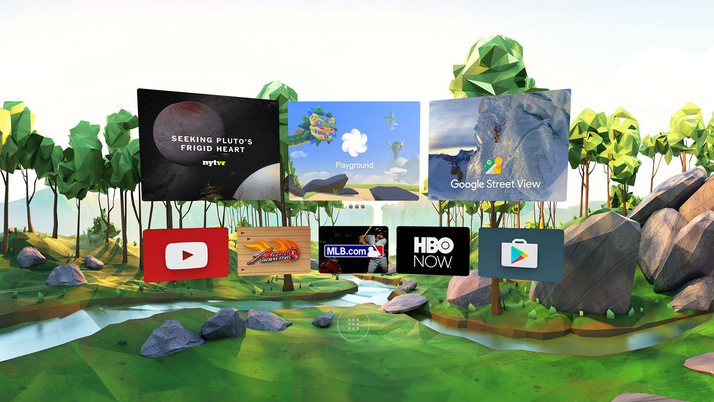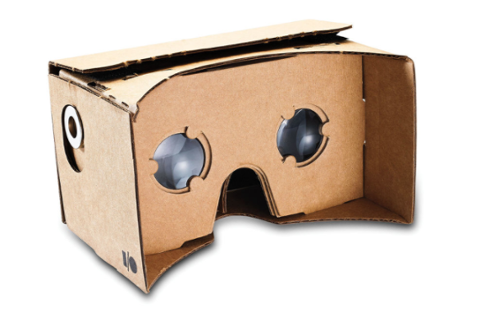 Google will launch a new storefront for virtual-reality apps and games in coming weeks, according to an article in Bloomberg. As part of that effort, the search-engine giant is reportedly investing vast sums of money in virtual-reality games and video, including productions by various YouTube stars. Google’s virtual-reality platform, codenamed Daydream, is based on Android Nougat, the latest update for its popular mobile operating system (it’s version 7.0 of Android, for those of you keeping score at home). Nougat began rolling out to a selection of Android phones this week, although some folks may end up waiting months for their update. At Google’s I/O conference this summer, Google executives demonstrated an early build of Daydream’s user interface, which included a home-screen that looked like a virtual forest (as seen in the image above) and VR-enabled versions of popular Google apps such as Street View. At the time, Google also showed conference attendees a reference design for a smartphone-powered VR headset, which also included a one-handed controller; such headsets are reportedly coming later this year. For those developers interested in building virtual-reality apps for Android, it’s worth checking out what the platform has to offer with regard to development tools. The Google VR SDK for Android supports not only Daydream on Nougat, but also Cardboard, the (very basic) API for Cardboard VR apps. In an Android context, the Google VR SDK provides a C/C++ API for developers writing native code. The SDK is designed to streamline some basic tasks associated with VR development, including head-tracking, 3D calibration, side-by-side rendering, and stereo geometry configuration. A sample app, Treasure Hunt, uses all of the SDK’s features, and provides a nice entrance into learning the intricacies of the platform. Via its documentation, Google also offers a step-by-step guide to starting your own Android VR project, either through Android Studio or directly using Gradle. For those who just want to embed 360-degree VR media into Websites on desktop and mobile, there are also instructions for making that happen. If Bloomberg’s reporting is correct, you may not have to wait long for a storefront to sell your VR wares.
Google will launch a new storefront for virtual-reality apps and games in coming weeks, according to an article in Bloomberg. As part of that effort, the search-engine giant is reportedly investing vast sums of money in virtual-reality games and video, including productions by various YouTube stars. Google’s virtual-reality platform, codenamed Daydream, is based on Android Nougat, the latest update for its popular mobile operating system (it’s version 7.0 of Android, for those of you keeping score at home). Nougat began rolling out to a selection of Android phones this week, although some folks may end up waiting months for their update. At Google’s I/O conference this summer, Google executives demonstrated an early build of Daydream’s user interface, which included a home-screen that looked like a virtual forest (as seen in the image above) and VR-enabled versions of popular Google apps such as Street View. At the time, Google also showed conference attendees a reference design for a smartphone-powered VR headset, which also included a one-handed controller; such headsets are reportedly coming later this year. For those developers interested in building virtual-reality apps for Android, it’s worth checking out what the platform has to offer with regard to development tools. The Google VR SDK for Android supports not only Daydream on Nougat, but also Cardboard, the (very basic) API for Cardboard VR apps. In an Android context, the Google VR SDK provides a C/C++ API for developers writing native code. The SDK is designed to streamline some basic tasks associated with VR development, including head-tracking, 3D calibration, side-by-side rendering, and stereo geometry configuration. A sample app, Treasure Hunt, uses all of the SDK’s features, and provides a nice entrance into learning the intricacies of the platform. Via its documentation, Google also offers a step-by-step guide to starting your own Android VR project, either through Android Studio or directly using Gradle. For those who just want to embed 360-degree VR media into Websites on desktop and mobile, there are also instructions for making that happen. If Bloomberg’s reporting is correct, you may not have to wait long for a storefront to sell your VR wares. Google Rolling Out Daydream VR
 Google will launch a new storefront for virtual-reality apps and games in coming weeks, according to an article in Bloomberg. As part of that effort, the search-engine giant is reportedly investing vast sums of money in virtual-reality games and video, including productions by various YouTube stars. Google’s virtual-reality platform, codenamed Daydream, is based on Android Nougat, the latest update for its popular mobile operating system (it’s version 7.0 of Android, for those of you keeping score at home). Nougat began rolling out to a selection of Android phones this week, although some folks may end up waiting months for their update. At Google’s I/O conference this summer, Google executives demonstrated an early build of Daydream’s user interface, which included a home-screen that looked like a virtual forest (as seen in the image above) and VR-enabled versions of popular Google apps such as Street View. At the time, Google also showed conference attendees a reference design for a smartphone-powered VR headset, which also included a one-handed controller; such headsets are reportedly coming later this year. For those developers interested in building virtual-reality apps for Android, it’s worth checking out what the platform has to offer with regard to development tools. The Google VR SDK for Android supports not only Daydream on Nougat, but also Cardboard, the (very basic) API for Cardboard VR apps. In an Android context, the Google VR SDK provides a C/C++ API for developers writing native code. The SDK is designed to streamline some basic tasks associated with VR development, including head-tracking, 3D calibration, side-by-side rendering, and stereo geometry configuration. A sample app, Treasure Hunt, uses all of the SDK’s features, and provides a nice entrance into learning the intricacies of the platform. Via its documentation, Google also offers a step-by-step guide to starting your own Android VR project, either through Android Studio or directly using Gradle. For those who just want to embed 360-degree VR media into Websites on desktop and mobile, there are also instructions for making that happen. If Bloomberg’s reporting is correct, you may not have to wait long for a storefront to sell your VR wares.
Google will launch a new storefront for virtual-reality apps and games in coming weeks, according to an article in Bloomberg. As part of that effort, the search-engine giant is reportedly investing vast sums of money in virtual-reality games and video, including productions by various YouTube stars. Google’s virtual-reality platform, codenamed Daydream, is based on Android Nougat, the latest update for its popular mobile operating system (it’s version 7.0 of Android, for those of you keeping score at home). Nougat began rolling out to a selection of Android phones this week, although some folks may end up waiting months for their update. At Google’s I/O conference this summer, Google executives demonstrated an early build of Daydream’s user interface, which included a home-screen that looked like a virtual forest (as seen in the image above) and VR-enabled versions of popular Google apps such as Street View. At the time, Google also showed conference attendees a reference design for a smartphone-powered VR headset, which also included a one-handed controller; such headsets are reportedly coming later this year. For those developers interested in building virtual-reality apps for Android, it’s worth checking out what the platform has to offer with regard to development tools. The Google VR SDK for Android supports not only Daydream on Nougat, but also Cardboard, the (very basic) API for Cardboard VR apps. In an Android context, the Google VR SDK provides a C/C++ API for developers writing native code. The SDK is designed to streamline some basic tasks associated with VR development, including head-tracking, 3D calibration, side-by-side rendering, and stereo geometry configuration. A sample app, Treasure Hunt, uses all of the SDK’s features, and provides a nice entrance into learning the intricacies of the platform. Via its documentation, Google also offers a step-by-step guide to starting your own Android VR project, either through Android Studio or directly using Gradle. For those who just want to embed 360-degree VR media into Websites on desktop and mobile, there are also instructions for making that happen. If Bloomberg’s reporting is correct, you may not have to wait long for a storefront to sell your VR wares. 


